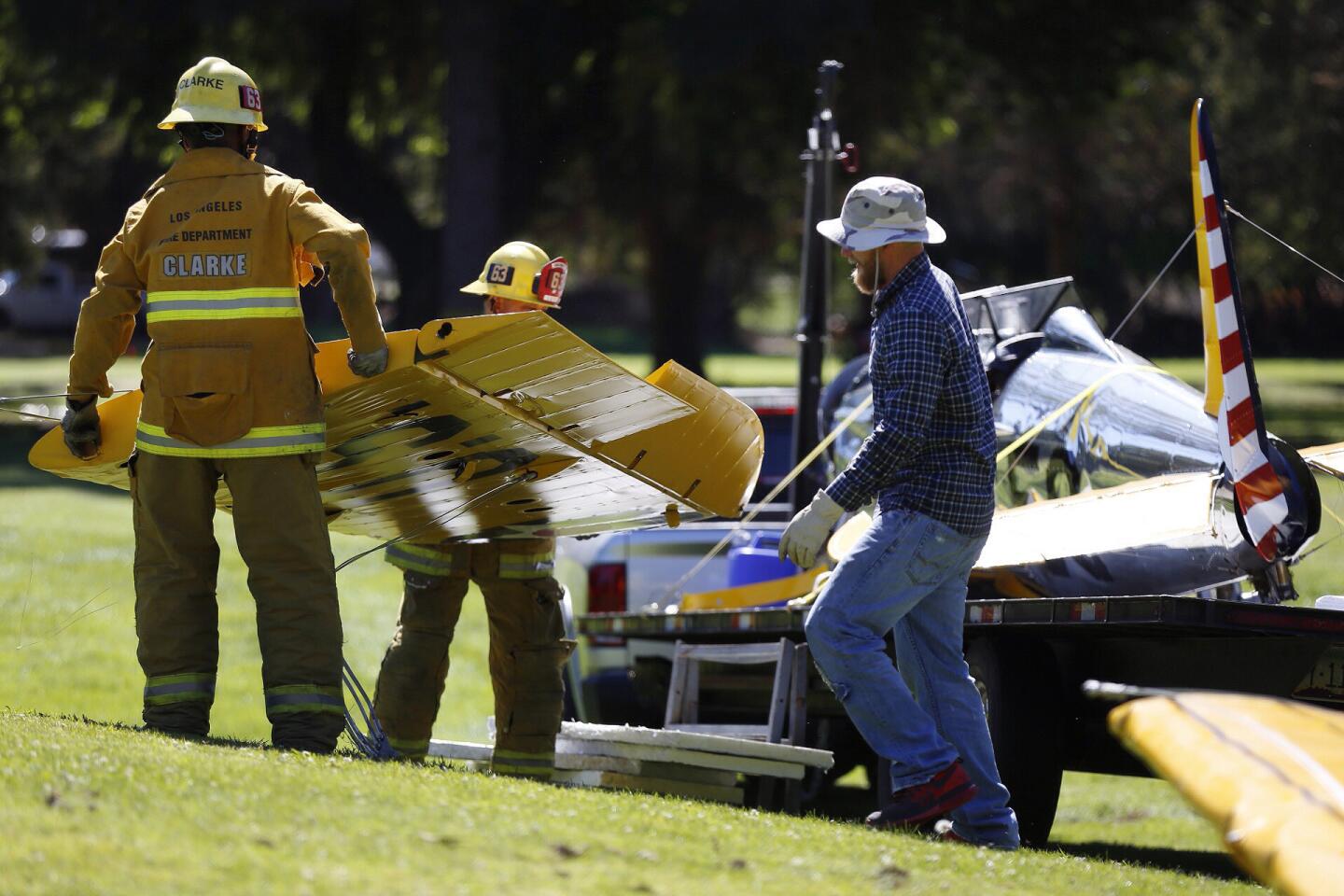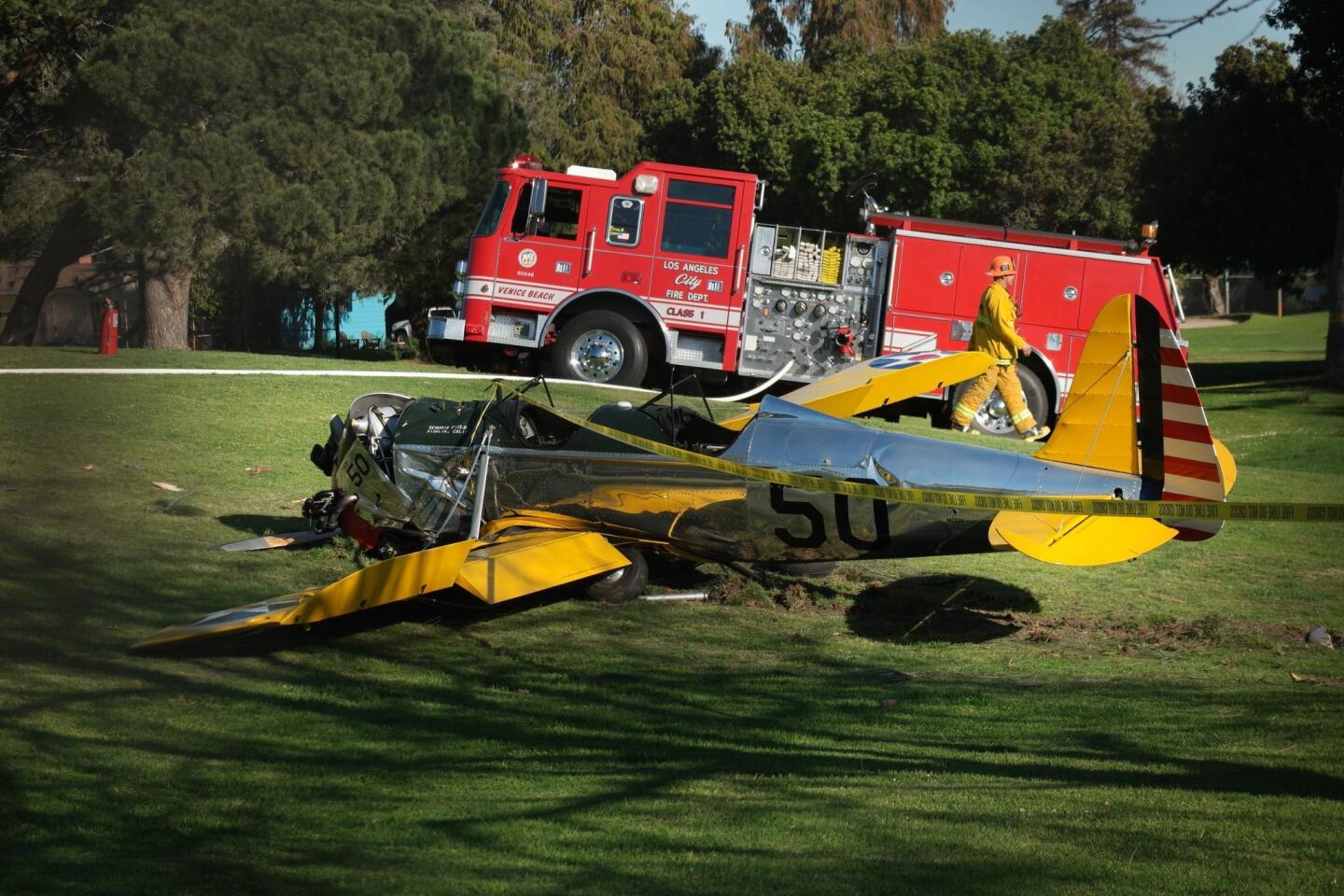Facing numerous obstacles, Harrison Ford did ‘best thing’ to land plane
- Share via
When the engine on actor Harrison Ford’s single-engine plane sputtered and died just after takeoff Thursday, a landscape of obstacles lay on the ground before him.
Homes, shopping centers and narrow beachside-community streets crisscross the two miles between the end of the airport landing strip and the sandy Santa Monica coastline.
Ford, 72, had few options, and according to Santa Monica flight instructor Jeff Martin, he made the right choice when he picked Venice’s Penmar Golf Course for his emergency landing site.
“I think he did the best thing he could’ve done, and he did the thing I’ve feared having to do every time I depart from there in a single-engine airplane,” said Martin, 38, who has been flying for 20 years.
Get essential California coverage
Patrick Jones, an investigator with the National Transportation Safety Board, said in a news conference Friday that at 2:20 p.m. the previous day, Ford departed Santa Monica Airport in a Ryan PT-22 Recruit heading west. Just minutes into the flight, he reported a loss of engine power and was trying to return to the airport to land on Runway 3. The plane clipped a tree and finally came to rest, partially smashed, on the golf course.
In Santa Monica, there are basically three choices for pilots facing a possible life-and-death situation, Martin said: Lincoln Boulevard, the beach and Penmar Golf Course.
“Because it’s so developed all around there, the golf course really is the best place. Gosh, we’ve had three or four people land there” since 2002.
The standard advice Martin gives unseasoned pilots when an engine dies is to keep the plane level and aim straight -- find a flat place to land. Ford is not unseasoned. His aviation history is long and well documented.
“If you’ve got enough altitude, hours built up, you know your plane’s glide performance,” Martin said. “You can make a more educated decision.”
But, he cautioned, “it’s never really a good idea to turn back to the airport” at an altitude of less than 1,000 feet.
Investigators have not said what Ford’s altitude was when the engine cut out.
“As a seasoned pilot, you always have a thought that if this thing quits, where am I going to land?” Martin said. “We’ve all thought of where we’re going to put this thing in Santa Monica.”
Ford was hospitalized with fair to moderate injuries, said Los Angeles Fire Department spokesman Erik Scott. “He was banged up,” Ford’s publicist said in the statement. “The injuries sustained are not life threatening.”
After the landing, a group of golfers helped pull Ford from the plane and began administering first aid, said Carlos Gomez, who lives just yards from the site of the crash on Dewey Street. Gomez was cooking when he heard the plane hit the ground outside.
At first, Ford lay motionless, but then he started to move. “So I was, like, good, he’s alive!” Gomez said.
Jones of the NTSB said the cause of the engine failure had not been determined.
Just after 10 a.m. Friday, firefighting personnel, an aeronautical mechanic and others huddled around the wreckage of Ford’s plane and began to take it apart.
The mechanic backed up a silver Dodge pickup truck, grabbed hand tools and began loosening screws and hammering away at the plane’s wings. Soon the first wing came off. Then the mechanic used a crane to lift the plane a few feet off the ground and removed a wheel. A firefighter lifted the remaining limp wing, and after a few hammer strikes, off it fell.
The mechanic then used the crane to lift the remaining body of the plane a few feet higher off the ground, and drove it about 20 yards away, the plane swaying unsteadily behind the truck. Officials loaded it into a long flatbed, attached the flatbed to the truck, and loaded the wings and the wheels. Just after 11 a.m., the truck drove away with the disassembled plane.
By afternoon, police had cleared the scene and the only clues that a plane had crashed on the golf course was the scarred turf.
The aircraft will be moved to an airport hangar, Jones said, where it will be examined. A preliminary report on the crash could take a couple of weeks to a month to release, and a final report won’t be available for about a year.
Los Angeles Times staff writer Veronica Rocha contributed to this report.
Twitter: @JosephSerna
More to Read
Sign up for Essential California
The most important California stories and recommendations in your inbox every morning.
You may occasionally receive promotional content from the Los Angeles Times.




























